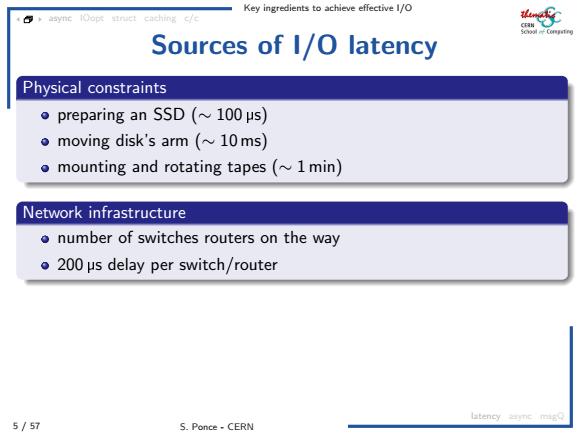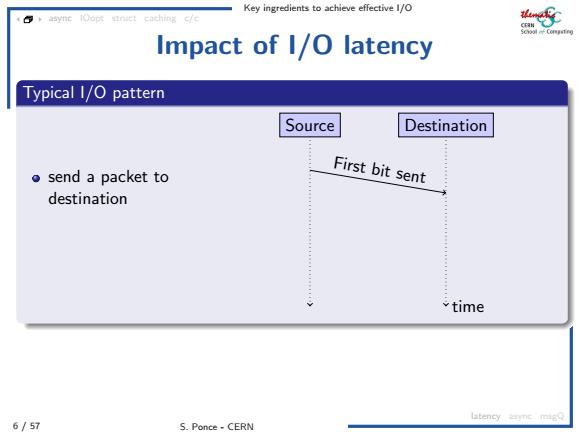
Key ingredients to achieve effective 1/O asyne l0op nact cachincc 花5 Sources of I/O latency Physical constraints preparing an SSD(~100 us) omoving disk's arm (~10ms) omounting and rotating tapes(1 min) latency amc mig 5/57 S.Ponce-CERN
Key ingredients to achieve effective I/O 5 / 57 S. Ponce - CERN async IOopt struct caching c/c latency async msgQ Sources of I/O latency Physical constraints preparing an SSD (∼ 100 ➭s) moving disk’s arm (∼ 10 ms) mounting and rotating tapes (∼ 1 min) Network infrastructure number of switches routers on the way 200 ➭s delay per switch/router “slow” speed of light “speed” of light is slower in a fiber (refractive index 1.47) that gives around 200 m ➭s −1 or 20 cm ns −1 Budapest’s ping time from CERN is ∼21 ms for ∼2500 km

Key ingredients to achieve effective 1/O caching c/c Sources of 1/O latency Physical constraints preparing an SSD(~100 us) omoving disk's arm (~10ms) o mounting and rotating tapes(1 min) Network infrastructure o number of switches routers on the way o 200 us delay per switch/router latency ac mig 5/57 S.Ponce-CERN
Key ingredients to achieve effective I/O 5 / 57 S. Ponce - CERN async IOopt struct caching c/c latency async msgQ Sources of I/O latency Physical constraints preparing an SSD (∼ 100 ➭s) moving disk’s arm (∼ 10 ms) mounting and rotating tapes (∼ 1 min) Network infrastructure number of switches routers on the way 200 ➭s delay per switch/router “slow” speed of light “speed” of light is slower in a fiber (refractive index 1.47) that gives around 200 m ➭s −1 or 20 cm ns −1 Budapest’s ping time from CERN is ∼21 ms for ∼2500 km

Key ingredients to achieve effective 1/O asyncOop4nut caching c/c Sources of I/O latency Physical constraints preparing an SSD(~100 us) moving disk's arm (10ms) o mounting and rotating tapes(~1 min) Network infrastructure o number of switches routers on the way 200 us delay per switch/router "slow"speed of light "speed"of light is slower in a fiber(refractive index 1.47) ·that gives around200mμs-1or20cmns-1 o Budapest's ping time from CERN is ~21ms for ~2500km latency ac mig 5/57 S.Ponce-CERN
Key ingredients to achieve effective I/O 5 / 57 S. Ponce - CERN async IOopt struct caching c/c latency async msgQ Sources of I/O latency Physical constraints preparing an SSD (∼ 100 ➭s) moving disk’s arm (∼ 10 ms) mounting and rotating tapes (∼ 1 min) Network infrastructure number of switches routers on the way 200 ➭s delay per switch/router “slow” speed of light “speed” of light is slower in a fiber (refractive index 1.47) that gives around 200 m ➭s −1 or 20 cm ns−1 Budapest’s ping time from CERN is ∼21 ms for ∼2500 km

Key ingredients to achieve effective 1/O asyne l0op nact cachinc Impact of I/O latency Typical I/O pattern Source Destination time latency ac mg 6/57 S.Ponce-CERN
Key ingredients to achieve effective I/O 6 / 57 S. Ponce - CERN async IOopt struct caching c/c latency async msgQ Impact of I/O latency Typical I/O pattern send a packet to destination wait for ack go to next block Source Destination time sending time efficiency = sending time sending time + ping time

Key ingredients to achieve effective 1/O asyne l0op nact cachinc Impact of I/O latency Typical I/O pattern Source Destination ●send a packet to First bit sent destination time 6/57 latency c mig S.Ponce-CERN
Key ingredients to achieve effective I/O 6 / 57 S. Ponce - CERN async IOopt struct caching c/c latency async msgQ Impact of I/O latency Typical I/O pattern send a packet to destination wait for ack go to next block Source Destination time First bit sent sending time efficiency = sending time sending time + ping time